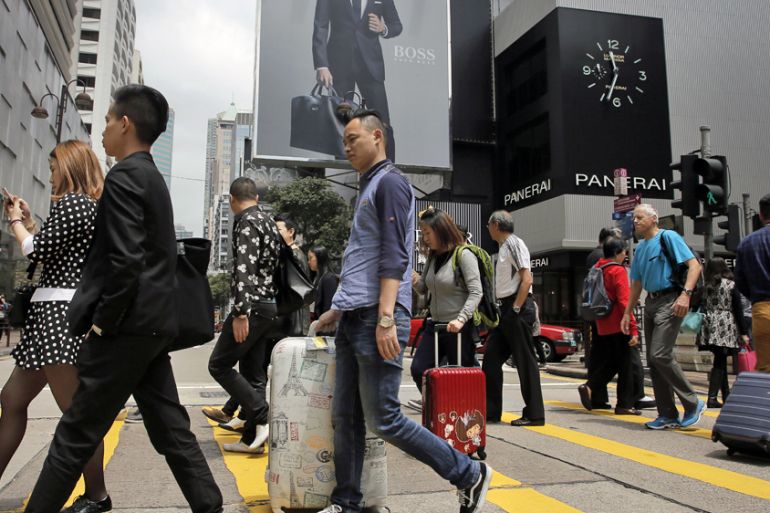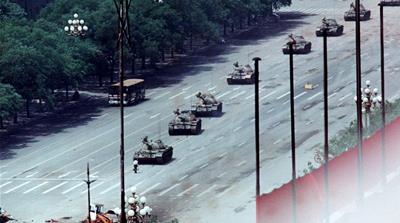Thirty years on: The rise and decline of the Chinese consumer
After the upheavals of 1989, consumption in China surged, but people are now starting to tighten their belts again.

Hong Kong, China – Two generations of Chinese people have spent most of their lives in an atmosphere of seemingly boundless economic possibility. But now, that looks like it may be changing.
An economic slowdown, compounded by a trade war with the United States that’s approaching its second year, is forcing many Chinese consumers to change not only how they spend, but also how they save, especially compared with their parents.
Keep reading
list of 4 items‘Triple spending’: Zimbabweans bear cost of changing to new ZiG currency
‘We share with rats’: Neglect, empty promises for S African hostel-dwellers
Thirty years waiting for a house: South Africa’s ‘backyard’ dwellers
“I don’t buy home appliances and furniture any more, but I spend more money on travelling abroad than before. I go to Europe at least twice every year and don’t save much money,” said Fanny Tang, a 31-year-old teacher originally from Jiangsu Province in mainland China.
But the mere thought of either going on overseas holidays or buying expensive home appliances would have been practically inconceivable to Chinese consumers 30 years ago.
As China witnessed one of its biggest social upheavals of the modern era – a violent crackdown on pro-democracy protests by authorities in Beijing’s Tiananmen Square on June 4, 1989, 30 years ago on Tuesday – the economy was still struggling to gain traction. The benefits of the economic transformation from communism to China’s own version of state-led capitalism that began under Deng Xiaoping in 1978 were still not being felt by the majority of Chinese people.
Turning point
But the Tiananmen Square crackdown was the trigger for a radical change in direction of the country’s economic management, says a prominent economist.

“The political crisis of June 1989 was the catalyst for a shift in the overall pattern of Chinese economic transition,” wrote Barry Naughton, a professor of Chinese international affairs at the University of California’s 21st Century China Center in a 2009 paper.
“After Tiananmen, while reformers still pursued a vision of a transformed economy, that vision was linked to, and often subordinated to, strengthened, stabilized and more effective government power,” Naughton wrote.
That shift appears to have paid off for the government and the Chinese economy.
In 1989, China’s gross domestic product, the main measure for the size of a country’s economy, was worth $348bn, according to the World Bank, about two-thirds the size of Canada’s and five percent of the US’s at that time. By 2004, it was valued at nearly four times the 1989 figure. Today, it’s more than seven times bigger than it was 30 years ago, and catching up with the US.
And the dividends have also been felt by the people. Life has improved for most Chinese.
In 1990, an average Chinese person could expect to live to 69, according to the World Bank. By 2017, that had risen to 76.
Average household incomes were in the low hundreds of dollars per year through the 1980s and early 1990s but reached $994 per month by July 2018, according to research firm CEIC. And spending has also shot up at the same rapid rate, rising from less than $500 per household in 1988 to nearly $4,000 in December, says CEIC.
By 2018, retail sales amounted to $5.5 trillion, according to China’s National Bureau of Statistics, almost 16 times as much as the entire Chinese economy three decades earlier.
More recently, the Chinese government has been trying to make domestic consumption a greater part of its economy as it attempts to insulate itself from the uncertainties caused by trade frictions with the US.
Young people living in cities have driven this growth in consumption. No urbanite under 30 has ever seen a serious economic slowdown, much less a recession, or has had to seriously consider the possibility of one.
As a result, consumption by Chinese people under the age of 35 has taken on outsized importance in the economy, accounting for 65 percent of all consumption and rising, according to Boston Consulting Group. Spending by young urban professionals is expected to grow at 11 percent on average between 2016 and 2021, twice as fast as spending by people 35 and over.
Belt-tightening
Until recently, all this spending has been geared towards fulfilling the more aspirational lifestyles that this group has come to expect. Young Chinese prioritise healthy foods, more education, and travel, rather than basic necessities or saving, according to Fung Business Intelligence Group.
But that’s changing as even young people begin to consider the need to save for a rainy day and to check spending.

Growth in retail sales has been slowing for some months and, in April, the slowdown was more pronounced than expected. While some analysts attribute the sharp drops to seasonal factors, a bigger shift in consumption patterns may be under way.
China’s retail sales increased by 7.2 percent year-on-year in April, dropping from an 8.7 percent growth rate in March. It was the smallest rise in retail sales since May 2003.
The biggest drops were in areas like home appliances, where sales growth fell to 3.2 percent from 15.2 percent a month earlier, and oil and oil products, where growth fell to nearly zero from 7.1 percent. Sales of garments and building materials actually contracted by 1.1 percent and 0.3 percent respectively.
Sales of new cars continued to fall, as they have been dropping for months, although the contraction in April of 2.1 percent was smaller than the 4.4 percent shrinkage in March.
And the Chinese retail sales uptick in March may have been a one-off, driven partially by people and businesses making purchases ahead of key events, something economists call front-loading.
“The unusual lift in March, mainly tied to seasonal factors and front-loading of production, was driven by a desire to maximise tax deductions before the manufacturing value-added tax rate was lowered in April,” Yue Su, a China economist at the Economist Intelligence Unit (EIU), told Al Jazeera.
In May, China’s official purchasing managers’ index (PMI) came in at 49.2, showing a contraction in factory activity. Another PMI survey published by private researchers Caixin and IHS Markit was flat from a month later at 50.2, barely above the 50 mark that separates growth from contraction.
The upshot is that business confidence has weakened, said Zhengsheng Zhong, director of macroeconomic analysis at CEBM Group, in a statement. He blames the ongoing trade war between China and the US.
“The trade tensions between the US and China are having an impact on confidence and the best way to respond to this is to boost the confidence of enterprises, residents and capital markets by carrying out favourable reforms and to undertake timely adjustments to regulations and controls.”
But the growth is unlikely to be as fast as it once was. Many young Chinese say that they spend more money on healthcare (beyond what the universal healthcare system in China provides), insurance and travel than anything else.
Gucci bags out, insurance in
“I spend more money on insurance than any other things,” said 32-year-old Claire Ma from Guangdong Province. “As I am an only child, I feel pressured to take care of them and myself. Also, the stock market in China is very unstable. This is why I have taken several health and life insurance policies during the past few years.”
The slowdown in spending has not gone unnoticed. The government has put in place a number of measures to help kick-start spending, including tax cuts and boosting infrastructure investments. But these are likely to be only band-aids, analysts say.
“Short-term stimulus of the government can only help with depleting inventories, but not sustained consumption growth,” said the EIU’s Wang. “New momentum will have to come from higher disposable income.”
But as today’s Chinese consumers prepare to tighten their belts following years of free spending, they’re faced with problems their forebears of 30 years ago could only have dreamed of.
Jihyun Kim and David Ho contributed to this story